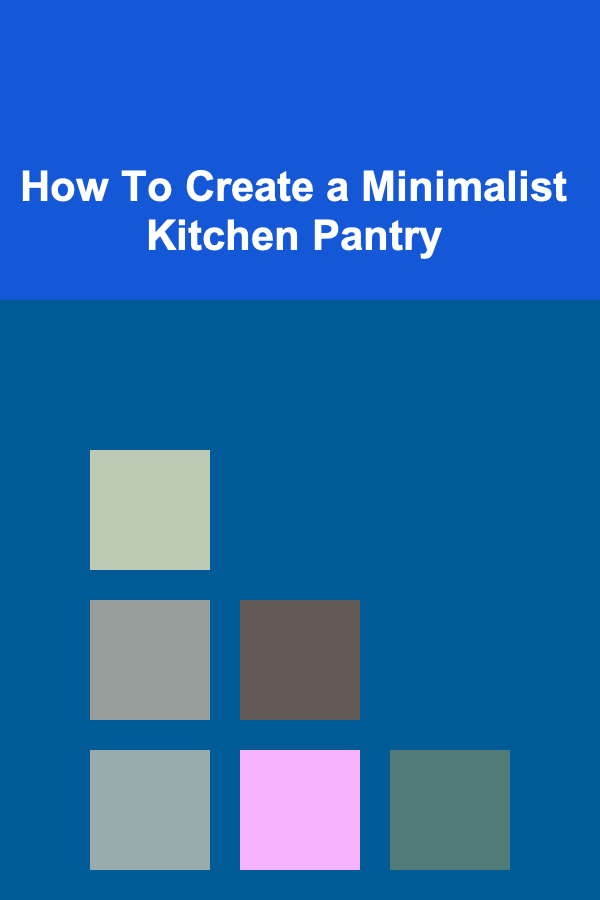
How To Create a Minimalist Kitchen Pantry
ebook include PDF & Audio bundle (Micro Guide)
$12.99$6.99
Limited Time Offer! Order within the next:

In today's fast-paced world, minimalism has emerged as a powerful philosophy, offering a path to intentional living and a respite from the overwhelming clutter that often fills our lives. Embracing minimalism in the kitchen, particularly in the pantry, can transform it from a chaotic storage space into an organized, efficient, and inspiring area for culinary creativity. A minimalist kitchen pantry is not about deprivation; it's about curating a collection of essential ingredients that support your cooking style, reduce food waste, and bring a sense of calm to your kitchen.
Understanding the Principles of a Minimalist Pantry
Before diving into the practical steps, it's crucial to grasp the core principles that underpin a minimalist pantry. These principles guide your decisions and ensure that your pantry remains functional and clutter-free over time:
- Intentionality: Every item in your pantry should have a purpose. Ask yourself: Do I use this regularly? Does it contribute to my cooking style? Does it bring me joy? If the answer to these questions is no, it's time to consider letting it go.
- Functionality: The pantry should be designed to maximize efficiency. Items should be easily accessible, and you should be able to quickly locate what you need.
- Quality Over Quantity: Focus on stocking high-quality, versatile ingredients rather than accumulating a vast array of rarely used items.
- Waste Reduction: Minimizing food waste is a key aspect of a minimalist pantry. This involves careful planning, mindful shopping, and proper storage techniques.
- Sustainability: Consider the environmental impact of your food choices and packaging. Opt for sustainable options whenever possible, such as buying in bulk, choosing reusable containers, and supporting local producers.
The Decluttering Process: A Necessary First Step
The first step towards creating a minimalist pantry is a thorough decluttering process. This involves taking everything out of your pantry, assessing each item, and making decisions about what to keep, donate, or discard. This process can be daunting, but breaking it down into smaller steps can make it more manageable:
- Empty the Pantry: Remove everything from your pantry, including food items, containers, and any other miscellaneous items. This allows you to see the space in its entirety and assess what you truly have.
- Check Expiration Dates: This is a critical step. Discard any expired or spoiled food items. Pay close attention to canned goods, spices, and condiments, as these often have expiration dates that are easily overlooked.
- Assess and Categorize: Group similar items together (e.g., grains, spices, canned goods). This will help you identify duplicates and assess the quantity of each category.
- The Questioning Process: For each item, ask yourself the following questions:
- Have I used this in the past six months?
- Do I have a specific recipe in mind for this ingredient?
- Do I enjoy this item?
- Is it easily replaceable?
- Would I buy this again? If you answer "no" to most of these questions, it's likely time to let go of the item. Be honest with yourself.
- The Three Piles: Create three piles: "Keep," "Donate," and "Discard." Be ruthless but realistic. The "Keep" pile should contain only items you use regularly and enjoy. The "Donate" pile should include unopened, unexpired items that you no longer need but are still usable. The "Discard" pile should contain expired or spoiled items.
- Handle with Care: Properly dispose of discarded items. Recycle empty containers whenever possible. Donate unwanted items to a local food bank or charity.
- Clean the Pantry: Once the pantry is empty, give it a thorough cleaning. Wipe down shelves, vacuum the floor, and address any stains or spills. This is also a good time to inspect for pests and take preventative measures if necessary.
Decluttering can be emotionally challenging, especially if you're attached to certain food items or have a tendency to hoard. Remember that the goal is not to deprive yourself, but to create a more functional and enjoyable space. Focus on the benefits of a minimalist pantry, such as reduced stress, less food waste, and more efficient meal preparation.
Organizing Your Minimalist Pantry: Practical Strategies
Once you've decluttered your pantry, the next step is to organize the remaining items in a way that maximizes space and efficiency. Thoughtful organization is key to maintaining a minimalist pantry long-term.
- Assess Your Space: Before you start organizing, take a moment to assess your pantry space. Consider the size, shape, and configuration of the shelves. This will help you determine the best way to utilize the available space.
- Zone It Out: Divide your pantry into zones based on category (e.g., baking supplies, snacks, grains, canned goods). This makes it easier to find what you need and keeps similar items together.
- Optimize Vertical Space: Use adjustable shelves to maximize vertical space. Install additional shelves if necessary. Consider using shelf risers or tiered organizers to create more storage levels.
- Clear Containers: Transfer dry goods, such as grains, pasta, and nuts, into clear, airtight containers. This not only keeps your food fresh but also allows you to easily see what you have and how much you have left. Choose uniform containers for a more cohesive look. Label everything clearly.
- Labeling is Key: Label all containers with the contents and expiration date (if applicable). Use a label maker or write neatly with a permanent marker. Consistent labeling helps prevent confusion and ensures that you use items before they expire.
- Baskets and Bins: Use baskets and bins to group smaller items together, such as snack bars, tea bags, or spice packets. This prevents clutter and makes it easier to grab what you need.
- First In, First Out (FIFO): Practice the FIFO method by placing newer items behind older items. This ensures that you use older items first, reducing the risk of food spoilage.
- Utilize Door Space: Install a spice rack or a narrow shelving unit on the inside of your pantry door to maximize space. This is a great place to store spices, condiments, or smaller items.
- Consider Your Cooking Style: Organize your pantry according to how you cook. If you bake frequently, keep baking supplies readily accessible. If you primarily cook savory dishes, prioritize spices and seasonings.
- Keep Frequently Used Items Within Reach: Place items you use most often at eye level and within easy reach. Less frequently used items can be stored on higher or lower shelves.
When choosing containers and organizers, opt for durable, easy-to-clean materials. Glass, stainless steel, and BPA-free plastic are good choices. Consider the overall aesthetic of your kitchen and choose containers that complement your décor.
Curating Your Essential Pantry Staples
A minimalist pantry is about more than just decluttering and organizing; it's about curating a collection of essential ingredients that support your cooking style and preferences. The specific staples you choose will depend on your individual dietary needs and culinary interests, but here are some general recommendations:
- Grains: Rice (white, brown, basmati), quinoa, oats, pasta (various shapes), flour (all-purpose, whole wheat)
- Legumes: Beans (black, kidney, pinto), lentils (green, red), chickpeas
- Canned Goods: Tomatoes (diced, crushed, paste), beans, vegetables (corn, peas, green beans), tuna, salmon
- Oils and Vinegars: Olive oil, vegetable oil, coconut oil, balsamic vinegar, apple cider vinegar
- Spices and Seasonings: Salt, pepper, garlic powder, onion powder, paprika, cumin, oregano, basil, chili powder, cinnamon
- Nuts and Seeds: Almonds, walnuts, peanuts, chia seeds, flax seeds
- Sweeteners: Sugar (white, brown), honey, maple syrup
- Condiments: Soy sauce, mustard, ketchup, mayonnaise, hot sauce
- Beverages: Coffee, tea
- Snacks: Nuts, dried fruit, popcorn, granola bars (choose healthier options)
This is just a starting point. Consider adding other staples that you use regularly, such as baking powder, baking soda, vanilla extract, broth, and dried herbs. Prioritize ingredients that are versatile and can be used in a variety of dishes.
When choosing brands, opt for high-quality ingredients that you enjoy. Don't be afraid to experiment with different brands to find your favorites. Consider buying in bulk to save money and reduce packaging waste, especially for frequently used items.
Maintaining Your Minimalist Pantry: Habits for Long-Term Success
Creating a minimalist pantry is just the first step. To maintain it over time, you need to develop sustainable habits that prevent clutter from accumulating. Here are some key strategies:
- Meal Planning: Plan your meals for the week before you go grocery shopping. This helps you buy only what you need and reduces the risk of impulse purchases.
- Grocery Lists: Always use a grocery list when you go shopping. Stick to the list and avoid buying items that aren't on it.
- Shop Smart: Shop frequently but buy less. This reduces the amount of food you have in your pantry at any given time and minimizes the risk of food spoilage.
- FIFO: Continue to practice the FIFO method, rotating items to ensure that older items are used first.
- Regularly Declutter: Set aside time each month (or every few months) to declutter your pantry. Check expiration dates, assess your inventory, and donate or discard any unwanted items.
- Put Things Back: After using an item, put it back in its designated place immediately. This prevents clutter from accumulating and keeps your pantry organized.
- Resist Impulse Buys: Be mindful of impulse purchases, especially when it comes to food. Ask yourself if you really need the item and if you will actually use it.
- Embrace Leftovers: Plan to use leftovers in creative ways to reduce food waste. Repurpose leftover vegetables into soup or stew, or use leftover meat in sandwiches or salads.
- Proper Storage: Store food items properly to extend their shelf life. Use airtight containers, store fruits and vegetables in the refrigerator, and keep dry goods in a cool, dry place.
- Be Flexible: Don't be afraid to adjust your pantry staples based on your changing needs and preferences. As your cooking style evolves, your pantry should evolve with it.
Maintaining a minimalist pantry is an ongoing process. It requires consistent effort and attention to detail. However, the benefits are well worth the effort. A minimalist pantry can save you time, money, and stress, and it can create a more enjoyable and efficient cooking experience.
The Psychological Benefits of a Minimalist Pantry
Beyond the practical benefits of organization and reduced waste, a minimalist pantry can have a significant positive impact on your mental well-being. The feeling of control and order that comes from a well-curated pantry can reduce stress and anxiety. A cluttered pantry can be visually overwhelming, contributing to a sense of chaos and overwhelm. By creating a minimalist pantry, you create a more peaceful and calming environment.
Furthermore, a minimalist pantry encourages mindful consumption. By being more intentional about the food you buy and consume, you become more aware of your eating habits and your relationship with food. This can lead to healthier choices and a greater appreciation for the food you eat.
The act of decluttering itself can be therapeutic. It allows you to let go of things you no longer need and to focus on what truly matters. This can be a liberating experience that extends beyond the pantry and into other areas of your life.
Finally, a minimalist pantry can inspire creativity in the kitchen. When you have a curated collection of high-quality ingredients, you're more likely to experiment and try new recipes. The absence of clutter allows you to focus on the joy of cooking and to express your culinary creativity.
Adapting Minimalism to Your Lifestyle: Personalizing Your Pantry
While the principles of minimalism provide a solid framework, it's important to adapt the concept to your individual lifestyle and needs. A minimalist pantry doesn't have to be identical for everyone. Consider your:
- Dietary Needs: If you have allergies, intolerances, or specific dietary restrictions (e.g., gluten-free, vegan), your pantry staples will reflect those needs.
- Cultural Background: Your pantry should include ingredients that are essential to your cultural cuisine.
- Cooking Style: Are you a baker, a home cook, or a gourmet chef? Your pantry should be tailored to your preferred cooking style.
- Household Size: A single person will have different pantry needs than a family of five.
- Frequency of Cooking: If you cook every day, you'll need a larger pantry than someone who eats out frequently.
- Local Availability: Consider what ingredients are readily available in your local area. Support local farmers and producers whenever possible.
Don't feel pressured to adhere to a strict definition of minimalism. The goal is to create a pantry that works for you and supports your individual needs and preferences. Experiment and adjust until you find a system that is both functional and sustainable.
Beyond the Pantry: Extending Minimalism to the Entire Kitchen
While this guide focuses on the pantry, the principles of minimalism can be applied to the entire kitchen. Consider decluttering your countertops, cabinets, and drawers. Invest in high-quality kitchen tools that you use frequently and get rid of any duplicates or rarely used items. A minimalist kitchen is a more efficient and enjoyable space to cook and prepare meals.
Consider these tips for extending minimalism to your entire kitchen:
- Declutter Countertops: Keep countertops clear of unnecessary items. Only keep essential items on the counter, such as a coffee maker, toaster, or fruit bowl.
- Organize Cabinets: Use organizers to maximize space in your cabinets. Group similar items together and keep frequently used items within easy reach.
- Declutter Drawers: Get rid of utensils and gadgets you don't use. Use drawer dividers to keep utensils organized.
- Invest in Quality Cookware: Choose durable, versatile cookware that will last for years.
- Minimize Appliances: Avoid buying unnecessary appliances. Choose multi-functional appliances whenever possible.
Conclusion: Embracing a More Intentional Kitchen Life
Creating a minimalist kitchen pantry is a journey, not a destination. It's an ongoing process of decluttering, organizing, and curating. By embracing the principles of minimalism, you can transform your pantry from a source of stress and clutter into a functional, efficient, and inspiring space for culinary creativity. The benefits extend beyond the pantry itself, impacting your mental well-being, your relationship with food, and your overall approach to kitchen life. Embrace the process, be patient with yourself, and enjoy the journey towards a more intentional and fulfilling kitchen experience. Start small, be consistent, and celebrate your progress. You'll be amazed at the positive impact a minimalist pantry can have on your life.

How to Maintain Your Stand Mixer for Longevity
Read More
How to Understand and Minimize Investment Fees
Read More
How To Build a Strong Social Media Measurement Framework
Read More
How To Apply Stoicism to Parenting
Read More
How To Overcome Writer's Block Permanently
Read More
Building Strong Relationships with Stakeholders: A Comprehensive Guide
Read MoreOther Products

How to Maintain Your Stand Mixer for Longevity
Read More
How to Understand and Minimize Investment Fees
Read More
How To Build a Strong Social Media Measurement Framework
Read More
How To Apply Stoicism to Parenting
Read More
How To Overcome Writer's Block Permanently
Read More